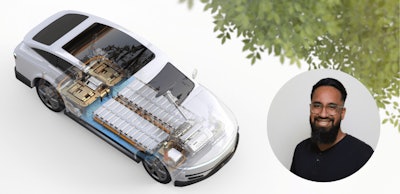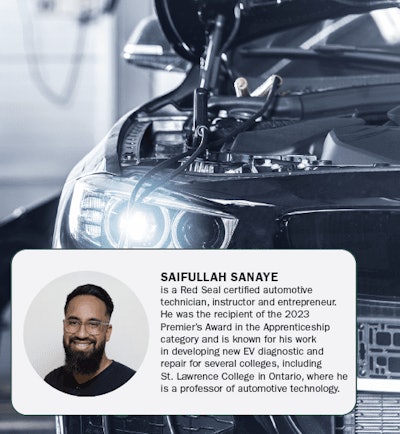
Navigating the Exciting Realm of Electric Vehicle Repairs
Column by SAIFULLAH SANAYE
The automotive industry is undergoing a profound transformation. The shift towards electric vehicles (EVs), the automation of vehicle assistance systems, and the potential for interconnecting all vehicles on the roadway herald a new era in transportation.
Yet, as we navigate this transition, there’s a need to address prevalent misconceptions, particularly concerning EV repair. There’s a lingering belief in some quarters that EVs—especially in the context of autobody repair—are excessively hazardous to work on. This concern, however, is largely unfounded. The EVs of today are engineered with safety as a paramount consideration.
Manufacturers have meticulously designed these vehicles to minimize the risk of electrocution from highvoltage systems. As I often stress in my training classes: Trouble finds those who seek it. Essentially, the dangers associated with EVs are largely contingent on one’s adherence to safety protocols. Following manufacturer procedures and utilizing proper personal protective equipment (PPE) significantly mitigates the risk. The apprehension isn’t solely about high voltage; there is also a fear of fire hazards, particularly concerning lithium-ion batteries. These batteries, integral to EVs, demand careful handling due to their sensitivity to temperature extremes. Bodyshops must recognize the potential risks: an overheated battery can lead to a severe fire. This concern is underscored in my classes when I query about the type of fire extinguisher effective against a lithium-ion battery blaze. The unanimous surprise upon learning that conventional extinguishers are ineffective is telling. Lithium-ion batteries, when overheated, enter a state known as thermal runaway–a cascade of overheating that can ignite a fire from a single cell. As I tell my students: When you see thermal runaway, you runaway!
If you encounter a thermal runaway case, pull the fire alarm and allow firefighters who have the proper equipment and the know-how to deal with the fire. Currently, there are no chemicals that will put out an EV-sized lithium ion battery fire. The current lack of a specific chemical agent to extinguish such fires underscores the importance of ongoing research in this area, in which I am actively involved.
Identifying the signs of thermal runaway is crucial. An unusual smell, often likened to bubble gum or fruit, is a primary indicator. This odour precedes the release of potentially harmful gases and, in extreme cases, powerful flames. Additionally, lithium-ion batteries may burst into flames if punctured in a manner that causes internal shorting, potentially triggering thermal runaway. In the event of a collision damaged EV arriving at a body shop, with evident battery damage, precautionary measures are essential. The vehicle should be isolated from structures, combustible materials, and other vehicles. It’s imperative for technicians working on EVs, particularly when dealing with high-voltage systems, to have specialized training and appropriate PPE. Consultation with experienced professionals, rather than reliance on informal sources like “Google mechanics,” is vital for safe and effective repairs. Adherence to manufacturer service information is non-negotiable.
So, should we fear these technologically advanced vehicles? The answer depends on preparedness. Without the right training and PPE, caution is warranted. However, with proper education and understanding of the risks and operational systems, technicians can confidently service these computers on wheels.
The dynamics in bodyshop differ significantly from regular automotive service centres. Auto body shops often deal with brand-new vehicles, whereas traditional service centres typically encounter newer technologies a few years post-purchase. This difference is largely due to the fact that vehicle collisions usually fall outside manufacturer warranties. In contrast, regular automotive service centres might not see EVs for high-voltage repairs as quickly, owing to extensive mileage and term limits on component warranties. Various EV models come with differing warranty terms, including long-term battery coverage and subscription-based lifetime warranties.
As EVs become increasingly prevalent, it’s imperative for the auto repair industry to stay abreast of technological advancements. By doing so, we can ensure that repairs are conducted safely and efficiently, aligning with the evolving landscape of automotive technology.






















